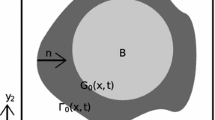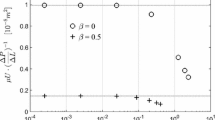Abstract
There is a need in the numerical simulation of reservoir performance to use average permeability values for the grid blocks. The permeability distributions to be averaged over are based on samples taken from cores and from logs using correlations between permeabilities and porosities and from other sources. It is necessary to use a suitable ‘effective’ value determined from this sample. The effective value is a single value for an equivalent homogeneous block. Conventionally, this effective value has been determined from a simple estimate such as the geometric mean or a detailed numerical solution of the single phase flow equation.
If the permeability fluctuations are small then perturbation theory or effective medium theory (EMT) give reliable estimates of the effective permeability. However, for systems with a more severe permeability variation or for those with a finite fraction of nonreservoir rock all the simple estimates are invalid as well as EMT and perturbation theory.
This paper describes a real-space renormalization technique which leads to better estimates than the simpler methods and is able to resolve details on a much finer scale than conventional numerical solution. Conventional simulation here refers to finite difference (or element) techniques for solving the single phase pressure equation. This requires the pressure and permeability at every grid point to be stored. Hence, these methods are limited in their resolution by the amount of data that can be stored in core. Although virtual memory techniques may be used they increase computer time. The renormalization method involves averaging over small regions of the reservoir first to form a new ‘averaged permeability’ distribution with a lower variance than the original. This pre-averaging may be repeated until a stable estimate is found. Examples are given to show that this is in excellent agreement with computationally more expensive numerical solution but significantly different from simple estimates such as the geometric mean.
Similar content being viewed by others

References
Bakr, A. A., Gelhar, L. W., Gutjahr, A. L., and McMillan, J. R., 1978, Water Resour. Res. 14, 263, 953.
Begg, S. H. and King, P. R., 1985, SPE 13529.
Begg, S. H., Chang, D. M., and Haldorsen, H. H., 1985, SPE 14271.
Dagan, G., 1981, Water Resour. Res. 17, 107.
Dagan, G., 1982, Water Resour. Res. 18, 813, 1571.
Dranfield, P., Begg, S. H., and Carter, R. R., 1987, in J. Brooks and K. Glennie, Petroleum Geology of North West Europe, Graham and Trotman, London.
Dupuy, M. and LeFebvre Du Prey, E., 1968, in Communication No. 34 Troisieme Colloque De L'Association De Recherche Sur les Techniques de Forage et de production, PAU, France.
Freeze, R. A., 1975, Water Resour. Res. 11, 725.
Gelhar, L. W., 1974, Water Resour. Res. 10, 539.
Gutjahr, A. L. and Gelhar, L. W., 1981, Water Resour. Res. 17, 337.
Gutjahr, A. L., Gelhar, L. W., Bakr, A. A., and MacMillan, J. R., 1978, Water Resour. Res. 14, 953.
Kadanoff, L. p., 1966, Physics 2, 263.
King, P. R., 1987, J. Phys. A. 20, 3935.
Kirkpatrick, S., 1973, Rev. Mod. Phys. 45, 574.
Koplik, J., 1982, Schlumberger-Doll Research Preprint.
Landau, L. D. and Lifshitz, E. M., 1960, Electrodynamics of Continuous Media, Pergamon Press, Oxford.
Mizell, S. A., Gutjahr, A. L., and Gelhar, L. W., 1982, Water Resour. Res. 18, 1053.
Sahimi, M., Scriven, L. E., and Davis, H. T., 1984, J. Phys. C 17, 941.
Smith, P. J. and Brown, C. E., 1982, SPE 11128.
Smith, L. and Freeze, R. A., 1979, Water Resour. Res. 15, 521, 1543.
Warren, J. E. and Price, H. S., 1963, SPEJ, September, 153.
Author information
Authors and Affiliations
Rights and permissions
About this article
Cite this article
King, P.R. The use of renormalization for calculating effective permeability. Transp Porous Med 4, 37–58 (1989). https://doi.org/10.1007/BF00134741
Received:
Revised:
Issue Date:
DOI: https://doi.org/10.1007/BF00134741



